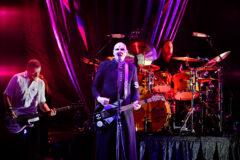JONATHAN DAYTON & VALERIE FARIS – “ROCKET”
Husband-and-wife duo Jonathan Dayton & Valerie Faris made most of their industry connections after working with Jane’s Addiction on the “Been Caught Stealing” video and later producing their film, Gift. Though “Rocket” is the least-known clip from Siamese Dream, it set the duo up to direct perhaps the two most-loved Smashing Pumpkins’ pieces a couple years later — “1979” and “Tonight, Tonight.” Dayton & Faris have subsequently directed the films Little Miss Sunshine and last year’s Ruby Sparks.
How did you guys start working with the Smashing Pumpkins?
Valerie Faris: We were doing a pilot with HBO called Peep Show and they agreed to appear in it. That was July or August of 1993.
Jonathan Dayton: The best thing that came out of it was that we developed this relationship with Billy and the band. After that, they asked us to do “Rocket.”
We really liked the idea of the old Pumpkins.—Valerie Faris
When you were coming up with the concept for “Rocket,” was there any aspect of the band you wanted to highlight that you felt was missing from the other videos?
Faris: Not that the other videos didn’t do this, but I think their sense of humor was something that we were attracted to. Doing the “Geek U.S.A.” live performance [for Peep Show], they were just funny. James Iha had this great sense of humor.
Dayton: We did this interview with him backstage and he was just so funny.
Faris: Very dry. So it was just coming up with this ridiculous concept. We really liked the idea of the old Pumpkins.
Dayton: The idea is that these kids get this transmission from outer space and seek out the Pumpkins, but by the time they get there, they discover they are really old.
Faris: It’s so stupid, but it’s always great to see a band that has a sense of humor about themselves. The Pumpkins could have been perceived as being a very serious band, kind of self-serious, but I think all of them have a great sense of humor about themselves and in general.
What do you remember about the shoot itself?
Dayton:We got a friend of ours, Ric Heitzman, who was one of the designers on Pee-Wee’s Playhouse, to do the rocket ship and the clubhouse. We didn’t have enough money to rent all the gear, so we thought, “Why don’t we go to where all the gear is?” So we rented a location that essentially came with all the stuff.
Faris: It was kind of a salvage yard of the aerospace industry.
Dayton: That way, we could just move stuff around.
Faris: And the rocket was built in the backyard of a house in Santa Clarita.
Dayton: That was the first time we used CG, when the rocket actually goes into space and lands on the planet. That was a big deal to find a place to do that.
Faris: It all has a Pee-Wee’s Playhouse quality.
How did the band respond to the final version?
Dayton: I think they loved it. They really thought it was funny when their alter egos appear at the end. We made these spacesuits and asked each of them to design their own logo. There are patches and those are based on their own thoughts on what they wanted. Those suits were all bought by the Hard Rock. They’re in some Hard Rock Cafe somewhere.
The video has that suburban feel, which you went back to for the “1979” video.
Dayton: For “Rocket,” we were struck by suburban houses that just seem so ridiculous.
Faris: The idea was a slightly more hellish suburbia.
Dayton: For the “1979” video, Billy had seen the movie Kids and talked to us about…
Faris: …a suburban version of lost kids. He grew up in suburban Chicago, and a lot of it is pulled from our teenage years growing up in suburbia and his.
Of all the directors who did videos for Siamese Dream, you’re the only ones the band worked with again. Once “Rocket” was over, did you feel like you had made a connection with them?
Dayton: It was great collaboration that lasted for three albums. You develop a tone and a shorthand. Our sensibilities just mixed well. We like to do very different things each time, and they appreciated that. We’re collaborative and Billy always had very strong ideas, and we like that. We didn’t want to impose our vision on the band.
Faris: There were a few bands we worked with multiple times, and we really valued that relationship. When you have that, there’s not a lot of interference. When you have that, nobody gets in the way.
Dayton: Nobody at the record company ever made changes. If we liked it and the band liked it, it was done. That was not always the case in those years.





